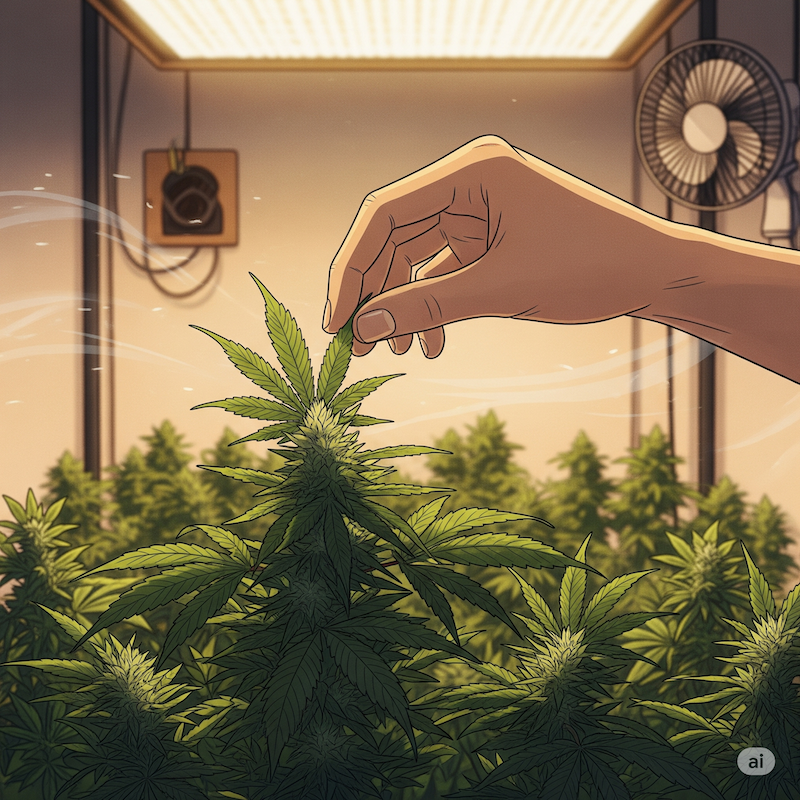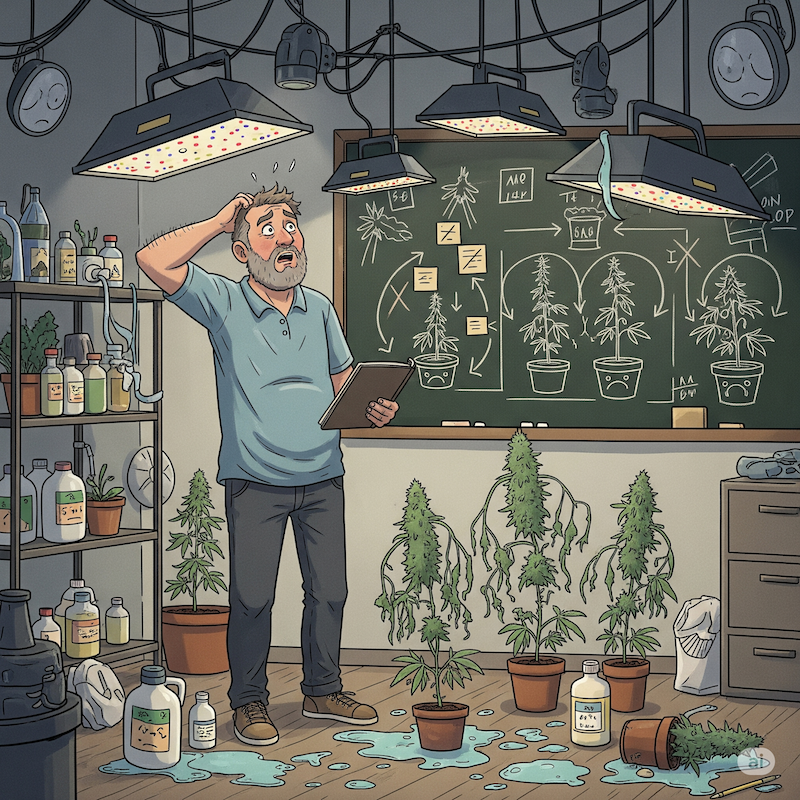G’day, legends! Matty here.
We all start with the books, right? pH charts, nutrient schedules, light cycles, airflow – trying to get every number spot on. And that’s fair dinkum, you gotta know the basics. But then you get a few grows under your belt, and suddenly, you feel like there’s something else at play. You’re staring at your plants, and it’s like they’re trying to tell you something, a little whisper, a gut feeling that goes beyond what the meters are saying.
That, mate, is your grower’s intuition, and it’s a bloody game-changer. It’s the art of really knowing your plants, not just their numbers. This guide is all about building that intuition – an essential skill that goes beyond scientific measurements and keeps your grow (and your sanity!) on track.
What is Cannabis Grower Intuition, Anyway?
So, what exactly is this grower’s intuition I’m banging on about? Nothing mystical, mate — just practical experience in disguise. Cannabis grower intuition is simply your accumulated experience, keen observation, and pattern recognition bubbling up as a “gut feeling.” It’s knowing something’s a bit off with your plants before the leaves even start to tell tales, or before your pH pen gives you a definitive reading.
Think of it like knowing your old ute’s about to conk out just by the sound of the engine, even before a warning light comes on. You just feel it in your bones, because you’ve spent enough time around that old battler to recognise every little cough and splutter. Your plants are no different.
Why does this intuition matter, especially when you’ve got all your fancy gadgets? Simple. It saves crops, lowers stress, and makes growing a whole lot more rewarding. It’s the difference between reacting to a problem once it’s a full-blown disaster, and nipping it in the bud before it even takes hold.

The Four Pillars of a Super-Intuitive Cannabis Grower
Building that sixth sense doesn’t happen overnight, but it’s a skill you can absolutely cultivate. It takes time, patience, and a willingness to learn. Here are the four main pillars that’ll turn you into a proper plant whisperer:
A. Patience: The Hardest Skill of All
Hands up if you’ve ever stood by your plants, willing them to grow faster, checking them every five minutes? Yeah, thought so. I’ve done it too, especially early on. I remember my first proper grow, I was like a kid on Christmas Eve, constantly poking, prodding, and adjusting. Ended up overwatering the poor buggers into oblivion because I couldn’t just wait for the soil to dry out. Rookie mistake, pure and simple, born from a complete lack of patience.
The hardest thing about growing, mate? Waiting. It’s like waiting for Christmas, only worse, because there’s always something you want to tinker with! But patience is the bedrock of intuition. It teaches you to:
- Resist the urge to over-tinker: Your plants usually just need consistent care, not constant intervention.
- Observe rather than react: Let them tell you what’s going on in their own time.
- Embrace the process: Enjoy the daily little changes, rather than stressing about the finish line.
B. Mastering Observation: More Than Meters
Your pH pen, your thermometer, your hygrometer – they’re all great tools. But your eyes, ears, and nose are actually your best mates in the grow room. Mastering observation means going beyond the numbers and really seeing your plants.
- Reading the Leaves: Don’t just look for crispy edges or yellow patches. Notice the subtle things: a slight change in the shade of green, a tiny bit of droop in the morning that perks up by afternoon, how “turgid” (full and firm) the leaves feel. Are they praying to the light, or looking a bit sad?
- Sensory Cues: What do different smells indicate? A healthy, vibrant aroma is good, but a sudden sour or ammonia smell can mean trouble brewing. Listen to your environment too – are the fans running smoothly? Is there any gurgling where there shouldn’t be?
- Matty’s Golden Tip: “Spend 5 minutes a day just looking at your plants. Don’t touch, don’t adjust, don’t measure. Just look. You’d be amazed what they’ll tell ya once you slow down and simply observe.”
C. Learning from Your Stuff-Ups (And Owning Them)
Let’s get one thing straight: everyone stuffs up. Matty included. The difference between a frustrated grower and a super-intuitive one is how you handle those boo-boos.
I once had a grow where I was convinced I was seeing a nutrient deficiency. I threw every bottle I had at them, one after another, trying to fix it. Turns out, I’d actually caused a massive nutrient lockout by overfeeding in the first place, and all my “fixes” just made it worse! My plants looked like they’d been run over by a tractor. It was a proper blow-up, but boy, did I learn from it.
- Embrace Failure: Every mistake is a lesson in disguise. If you kill a plant, or half your crop goes sideways, don’t beat yourself up. Work out why it happened.
- Post-Mortem Your Grows: Keep a grow journal. Write down what you did, what you saw, what went wrong, what you tried to fix it. Take photos! This is how you build your intuition – by consciously recognizing patterns of cause and effect. “You can’t learn from history if you don’t record it, aye!”
D. Reading the Environment Like a Pro
You can have all the fancy meters in the world, mate, but nothing beats knowing your grow room’s vibe just by stepping inside. This is about taking your environmental control to the next level – reading the air, the temperature, and the humidity not just from a display, but from how it feels to you and how your plants react.
Your plants are highly sensitive to their surroundings. A healthy plant will show it, not just by growing big but by how it carries itself. Are the leaves perkier in one spot than another? Is there a subtle rustle from the fans that wasn’t there yesterday? Are you feeling a bit sticky from the humidity yourself?
Matty’s relatable note: “If it’s too hot for you, it’s probably too hot for your green mates! Simple as that. Your comfort in the grow space is often a good indicator of theirs. Keep that airflow crankin’ like a backyard barbie, not like a stuffy broom closet.”
Learning to feel the environment, rather than just read a digital number, will give you an early warning system for stress, mould issues, or stunted growth. That’s pure intuition at play.

Protecting Your Sanity (and Your Relationships!)
Right, let’s have a serious chat, grower to grower. This hobby, this passion, this absolute obsession we have with our plants… it can get a bit much sometimes, can’t it?
The Grower’s Obsession Trap
It’s bloody easy to fall into the grower’s obsession trap. You start with good intentions, but suddenly you’re checking your plants five times a day, waking up in a cold sweat about a slightly yellow leaf, and boring anyone who’ll listen with intricate details of your nutrient regimen. Your grow lights probably have a better social life than you do!
I’ve been there, mate. My missus reckons I spend more time with my plants than with her. Might be true, but at least the plants don’t complain about my socks! Jokes aside, it’s vital to set boundaries. Your plants need consistent care, not constant hovering. Over-parenting your plants can be just as bad as neglecting them. Believe me.
Enjoy the Process
Remember why you started this journey in the first place. Was it the thrill of cultivating something amazing? The satisfaction of seeing your efforts literally blossom? The joy of sharing your harvest?
Don’t let the pursuit of perfection suck all the fun out of it. The path to becoming a super-intuitive grower is about learning, enjoying the process, and understanding that not every single leaf has to be flawless. It’s about balance, just like life itself. Your plants thrive when you’re happy, too.
Matty’s Final Wise Words: Trust Your Gut, Mate!
So, there you have it, legends. Building your grower’s intuition isn’t about buying more gear or reading every scientific paper under the sun. It’s about cultivating a deeper connection with your plants, honing your powers of observation, embracing your mistakes as lessons, and, crucially, learning to trust that little voice in your head.
You’ve put in the hard yards reading, setting up, and getting your hands dirty. You’ve built the skills, seen the cycles, and experienced the triumphs and the occasional face-plant. All that experience sits inside you, waiting to be tapped.
Next time you’re in the grow room, slow down. Take a deep breath. Look at your plants. Listen to the hum of your fans. Trust your gut. You’ve got this, legend!
Happy growing, and remember to always keep it green!
Cheers,
Matty
Aussie Hemp Seeds
👉 Matty’s One-Minute Grower’s Intuition Checklist:
- ✔️ Pause before you tinker — breathe, and observe.
- ✔️ Look, don’t touch, for 5 minutes each day.
- ✔️ Check if the grow room feels comfy (heat, humidity, airflow).
- ✔️ Listen for unusual noises — fans or pumps sounding off?
- ✔️ Smell for sour or musty odours early.
- ✔️ Record quick notes or photos in your grow journal.
Trust your gut, mate — you’ve got this! 💚
 AUS Stock - Local Delivery
AUS Stock - Local Delivery
I have never looked studied observed looked at analysed photographed or contemplated any other thing as intensely as cannabis plants. Sitting on a stool gazing at them for over an hour letting them talk to me.
And patience.. the lack of it has cost me more than once.
Stephen